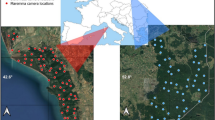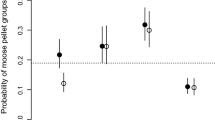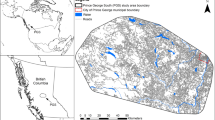Abstract
Various management plans have been developed to mitigate the effects of human activities on threatened woodland caribou (Rangifer tarandus caribou) populations. Most plans do not account for the behavior of wolves (Canis lupus), their main predator. The success of caribou recovery plans may nonetheless depend on how landscape management shapes wolf-caribou interactions. We evaluated the species-specific responses of caribou and wolves to a management plan in Québec, and assessed its impact on the probability of wolf-caribou co-occurrence. Landscape management consisted of the protection of large forest blocks, and the spatial aggregation of cutblocks. Based on telemetry data, we modeled animal-habitat spatial relationships with resource selection functions, and then estimate the relative probability of wolf-caribou co-occurrence. We found that caribou selected mature conifer forests with lichen. Wolves selected mixed and deciduous stands. Caribou avoided roads and cutblocks, while wolves selected them, which resulted in a relatively low probability of co-occurrence in harvested areas. Concurrent habitat selection by the two species was such that the highest probability of wolf-caribou co-occurrence took place in protected forest blocks (PB) from December to May. For efficient mitigation measures, the location of PBs should be selected while accounting for differences in habitat selection between wolf and caribou. The blocks should include mature conifer forests with lichen, minimize the abundance of mixed and deciduous stands, and be far from roads and cutblocks. Consideration of predator behavior can improve suitability of landscape management plans for the long-term persistence of threatened prey populations under top-down control.




Similar content being viewed by others

References
Aldridge CL, Boyce MS (2007) Linking occurrence and fitness to persistence: a habitat-based approach for endangered greater sage-grouse. Ecol Appl 17:508–526
Apollonio M, Mattioli L, Scandura M, Mauri L, Gazzola A, Avanzinelli E (2004) Wolves in the Casentinesi forests: insights for wolf conservation in Italy from a protected area with a rich wild prey community. Biol Conserv 120:249–260
Bates D, Sarkar D (2006) Linear mixed-effects models using S4 classes. R package version 0.995-2
Bergerud AT, Elliot JP (1986) Dynamics of caribou and wolves in northern British Columbia. Can J Zool 64:1515–1529
Boyce MS, Vernier PR, Nielsen SE, Schmiegelow FKA (2002) Evaluating resource selection functions. Ecol Modell 157:281–300
Brown GS, Rettie WJ, Brooks RJ, Mallory FF (2007) Predicting the impacts of forest management on woodland caribou habitat suitability in black spruce boreal forest. For Ecol Manage 245:137–147
Carroll C, Noss RF, Paquet PC (2001) Carnivores as focal species for conservation planning in the Rocky Mountain Region. Ecol Appl 11:961–980
Committee on the Status of Endangered Wildlife in Canada (COSEWIC) (2006) Canadian species at risk. Ottawa, Ontario
Courtois R, Ouellet JP, Gagné B (1998) Characteristics of cutovers used by moose (Alces alces) in early winter. Alces 34:210–211
Courtois R, Ouellet JP, Dussault C, Gingras A (2004) Forest management guidelines for forest-dwelling caribou in Québec. For Chron 80:598–606
Courtois R, Sebbane A, Gingras A, Rochette B, Breton L, Fortin D (2006) Changement d’abondance et adaptations du caribou dans un paysage sous aménagement. Ministère des Ressources naturelles et de la Faune, Québec
Courtois R, Ouellet JP, Breton L, Gingras A, Dussault C (2007) Effects of forest disturbance on density, space use, and mortality of woodland caribou. Ecoscience 14:491–498
Crête M, Courtois R (1997) Limiting factors might obscure population regulation of moose (Cervidae: Alces alces) in unproductive boreal forests. J Zool 242:765–781
Debinski DM, Holt RD (2000) A survey and overview of habitat fragmentation experiments. Conserv Biol 14:342–355
Dussault C, Courtois R, Ouellet JP, Huot J (2001) Influence of satellite geometry and differential correction on GPS location accuracy. Wildl Soc B 29:171–179
Dussault C, Ouellet J-P, Courtois R, Huot J, Breton L, Jolicoeur H (2005) Linking moose habitat selection to limiting factors. Ecography 28:619–628
Fahrig L (2003) Effects of habitat fragmentation on biodiversity. Annu Rev Ecol Evol Soc 34:487–515
Fahrig L (2007) Non-optimal animal movement in human-altered landscapes. Func Ecol 21:1003–1015
Fazey I, Fischer J, Lindenmayer DB (2005) What do conservation biologists publish? Biol Conserv 124:63–73
Fortin D, Beyer HL, Boyce MS, Smith DW, Duchesne T, Mao JS (2005) Wolves influence elk movements: behavior shapes a trophic cascade in Yellowstone National Park. Ecology 86:1320–1330
Fortin D, Courtois R, Etcheverry P, Dussault C, Gingras A (2008) Winter selection of landscapes by woodland caribou: behavioural response to geographical gradients in habitat attributes. J Appl Ecol 45:1392–1400
Gillies CS, Hebblewhite M, Nielsen SE, Krawchuk MA, Aldridge CL, Frair JL, Saher DJ, Stevens CE, Jerde CL (2006) Application of random effects to the study of resource selection by animals. J Anim Ecol 75:887–898
Gingras A, Audy A, Courtois R (1989) Inventaire aérien de l’orignal dans la zone de chasse 19 à l’hiver 1987–1988. Ministère du Loisir, de la Chasse et de la Pêche. Direction de la gestion des espèces et des habitats, Québec
Graham MH (2003) Confronting multicollinearity in ecological multiple regression. Ecology 84:2809–2815
Gustine DD, Parker KL, Lay RJ, Gillingham MP, Heard DC (2006a) Interpreting resource selection at different scales for woodland caribou in winter. J Wildl Manage 70:1601–1614
Gustine DD, Parker KL, Lay RJ, Gillingham MP, Heard DC (2006b) Calf survival of woodland caribou in a multi-predator ecosystem. Wildl Monogr 165:1–32
Hebblewhite M, Merrill E (2008) Modelling wildlife-human relationships for social species with mixed-effects resource selection models. J Appl Ecol 45:834–844
Hebblewhite M, Merrill E, McDonald TL (2005) Spatial decomposition of predation risk using resource selection functions: an example in a wolf-elk predator-prey system. Oikos 111:101–111
ISATIS (2007) Isatis technical references, v.7.0, Geovariances et Ecole des Mines de Paris
James ARC, Boutin S, Hebert DM, Rippin AB (2004) Spatial separation of caribou from moose and its relation to predation by wolves. J Wildl Manage 68:799–809
Johnson CJ, Parker KL, Heard DC (2001) Foraging across a variable landscape: behavioral decision made by woodland caribou at multiple scales. Oecologia 127:590–602
Kunkel KE, Pletscher DH (2000) Habitat factors affecting vulnerability of moose to predation by wolves in southeastern British Columbia. Can J Zool 78:150–157
Laurance WF (2000) Do edge effects occur over large spatial scales? Trends Ecol Evol 15:134–135
Lima SL, Dill LM (1990) Behavioral decisions made under the risk of predation: a review and prospectus. Can J Zool 68:619–640
Manly BFJ, McDonald LL, Thomas DA, McDonald TL, Erickson WE (2002) Resource selection by animals, statistical design and analysis for field studies, 2nd edn. Kluwer, Dordrecht
Mao JS, Boyce MS, Smith DW, Singer FJ, Vales DJ, Vore JM, Merrill EH (2005) Habitat selection by elk before and after wolf reintroduction in Yellowstone National Park. J Wildl Manage 69:1691–1707
Messier F (1994) Ungulate population models with predation: a case study with the North American moose. Ecology 75:478–488
Mladenoff DJ, Sickley TA, Haight RG, Wydeven AP (1995) A regional landscape analysis and prediction of favorable gray wolf habitat in northern Great Lakes region. Conserv Biol 9:279–294
Morris DW (2003) How can we apply theories of habitat selection to wildlife conservation and management? Wildl Res 30:303–319
R Development Core Team (2006) R: a language and environment for statistical computing. R foundation for statistical computing, Vienna, Austria. Available from http://www.R-project.org
Racey GD, Harris A, Gerrish L, Armstrong T, McNicol J, Baker J (1999) Forest management guidelines for the conservation of woodland caribou: a landscape approach. MS Draft. Ontario Ministry of Natural Resources, Thunder Bay
Rettie WJ, Messier F (1998) Dynamics of woodland caribou populations at the southern limit of their range in Saskatchewan. Can J Zool 76:251–259
Rettie WJ, Messier F (2000) Hierarchical habitat selection by woodland caribou: its relationship to limiting factors. Ecography 23:466–478
Ryall KL, Fahrig L (2006) Response of predators to loss and fragmentation of prey habitat: a review of theory. Ecology 87:1086–1093
Schaefer JA (2003) Long-term range recession and the persistence of caribou in the taiga. Conserv Biol 17:1435–1439
Schaefer JA (2007) A review of Manitoba’s conservation and recovery strategy for boreal woodland caribou. Sierra Club of Canada, Canadian Parks and Wilderness Society, Manitoba
Schneider MF (2001) Habitat loss, fragmentation and predator impact: spatial implications for prey conservation. J Appl Ecol 38:720–735
Seip DR (1992) Factors limiting woodland caribou populations and their interrelationships with wolves and moose in southeastern British Columbia. Can J Zool 70:1494–1503
Seip DR (1998) Ecosystem management and the conservation of caribou habitat in British Columbia: what does it mean to put caribou knowledge into an ecosystem context? Rangifer Special Issue 10:203–211
Trombulak SC, Frissell CA (2000) Review of ecological effects of roads on terrestrial and aquatic communities. Conserv Biol 14:18–30
Wackernagel H (2003) Multivariate geostatistics. An introduction with applications, 3rd edn. Springer, Berlin
Wilhere GF (2002) Adaptative management in habitat conservation plans. Conserv Biol 16:20–29
Wittmer HU, Sinclair RE, McLellan BN (2005) The role of predation in the decline and extirpation of woodland caribou. Oecologia 114:257–267
Acknowledgments
Financial supports for field efforts and data analysis were funded by the Natural Sciences and Engineering Research Council of Canada (NSERC)—Sylviculture and Wildlife Research Chair, Ministère des Ressources Naturelles et de la Faune du Québec, the Canadian Foundation for Innovation, and Fondation de la faune du Québec. We address special thanks to M. Houle for her preliminary analyses on wolves, and to E. Azeria for his comments on the paper. We thank L. Breton, B. Rochette, B. Baillargeon and D. Gay for their help in the field.
Author information
Authors and Affiliations
Corresponding author
Rights and permissions
About this article
Cite this article
Courbin, N., Fortin, D., Dussault, C. et al. Landscape management for woodland caribou: the protection of forest blocks influences wolf-caribou co-occurrence. Landscape Ecol 24, 1375–1388 (2009). https://doi.org/10.1007/s10980-009-9389-x
Received:
Accepted:
Published:
Issue Date:
DOI: https://doi.org/10.1007/s10980-009-9389-x



